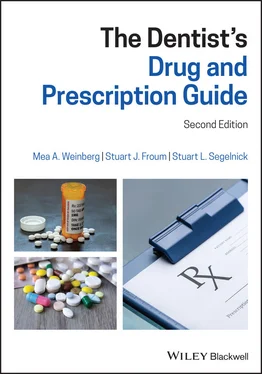1 Q. What is the definition of pharmacokinetics and why is it important to know?
2 A. Pharmacokinetics describes the actions of the drug as it moves through the body and how the body influences drug concentrations. It is easiest to remember pharmacokinetics by the acronym: ADME (A = absorption into the systemic circulation; D = distribution to the target tissues and organs; M = metabolism or biotransformation; E = elimination from the body). It is important to know the basics of pharmacokinetics in order to understand the basic principles of prescribing medications (Doogue and Polasek 2013). Pharmacokinetics (e.g., absorption of the drug into the blood) may be altered when certain antibiotics prescribed in dentistry are taken with food. Instructions must be verbally expressed to the patient and documented in the patient's chart on how to take medications that are prescribed by dentists (e.g., antibiotics, antimicrobial agents, analgesics, antifungal agents, antiviral agents, fluorides).
3 Q. What factors affect the rate of drug absorption?
4 A. In the gastrointestinal tract, many factors can influence the rate of drug absorption into the systemic circulation such as acidity of the stomach and food in the stomach. Some medications used in dentistry should be taken with food to reduce gastrointestinal irritation, some medications should be taken on an empty stomach because the food could delay the absorption of the drug, and some can be taken with or without food because food does not interfere with absorption. Usually, the absorption of the total amount of drug is not reduced but rather it will just take longer to be absorbed. Usually, antibiotics have the most restrictions regarding taking with meals. Nonsteroidal antiinflammatory drugs such as ibuprofen must be taken with food to avoid gastric irritation. Specific drugs will be discussed within the relevant chapters.
5 Q. What does “take on an empty stomach” mean?
6 A. “Take on an empty stomach” means to take the drug within one hour before eating or two hours after eating. Take on an empty stomach is not interpreted as not eating.
7 Q. What is the pharmacokinetics of an orally administered drug?
8 A. The pharmacokinetics of a drug administered orally such as penicillin VK is as follows (Gossel 1998a,b; Weinberg 2013).An orally administered drug is swallowed and goes down the esophagus. It is important to take a tablet/capsule with a full glass of water to facilitate its passage through the esophagus into the stomach.In the stomach, the tablet/capsule must be released or liberated from its formulation. Once a tablet is “broken up” and a capsule is “opened,” and the active ingredients are released, there is dissolution of the drug from the liberated drug particles. Some acidic drugs are enteric coated to protect the stomach lining. Dosage forms such as syrups or solutions are liquids, which are immediately available for absorption and transport. A liquid gel capsule (Aleve®, Advil®) is formulated to dissolve quickly, allowing the liquid inside the capsule to be absorbed fast.Drug goes into the upper part of the small intestine (duodenum) where most absorption into the systemic circulation occurs. This is because the small intestine has a large surface area due to microvilli, through which drugs may diffuse.From the small intestine, the drug molecules are absorbed into the bloodstream. Many factors can affect the rate and extent of drug absorption, including foods and minerals. For example, tetracycline should not be given at the same time as dairy products or minerals (e.g., iron, calcium, magnesium) because insoluble complexes form in the intestinal tract, which slows down absorption. This can be avoided by taking the tetracycline 1–2 hours before or after the dairy/mineral product. Some antibiotics (e.g., tetracycline) must be taken on an empty stomach (one hour before or two hours after meals), which increases the rate of absorption. Most antibiotics can be taken without regard to meals (with or without food) but if stomach upset occurs, these antibiotics can be taken with food (Huang et al. 2009).Absorption occurs when a drug is in a nonionized or charged form and if it is more lipid soluble. Most drugs are combined with a salt to enhance absorption (e.g., lidocaine HCl, tetracycline HCl, doxycycline hyclate, amoxicillin trihydrate).Before an orally administered drug reaches the systemic circulation, it goes to the liver via the portal vein whereby it is immediately exposed to metabolism by liver enzymes (Huang et al. 2009). This first exposure is referred to as the first‐pass effect. Some drugs such as lidocaine and morphine that undergo extensive first‐pass embolism will become inactive so they cannot be given orally. Diazepam (Valium®) has close to 100% bioavailability (low first‐pass metabolism) so it has similar oral and intravenous doses. Alternate routes of drug administration that bypass the first‐pass effect include sublingual, rectal, and parenteral (intravenous, intramuscular, subcutaneous) (Fagerholm 2007; Pond and Tozer 1984; Robertson 2017).Once it reaches systemic circulation, the drug is distributed in the blood to the various organs. Many drugs are bound to circulating proteins such as albumin (acidic drugs) and glycoproteins (basic drugs). Highly protein‐bound drugs are not active and only the free drug that is not bound to proteins is active.Once the drug has exerted its actions, it must then be eliminated from the body. The first part of drug elimination involves metabolism or biotransformation, which occurs mostly in the liver. It may take a drug several passes through the liver before it is entirely metabolized. Biotransformation converts lipid‐soluble drug molecules to metabolites or endproducts that are more water soluble and therefore easier to eliminate from the body. Most of the conversion of drugs occurs in the liver by metabolizing enzymes called microsomal enzymes. These enzymes, which are also called cytochrome P450 (CYP) enzymes, are the primary enzymes responsible for the oxidation of many drugs. There are many different isoenzymes for different drugs (e.g., CYP3A4 is involved with many dental drugs). Many drug–drug and drug–food interactions occur via the microsomal enzymes. Some prodrugs have no pharmacological activity unless they are first metabolized to the active form in the body (e.g., codeine is metabolized by the liver enzyme CYP2D6 to the active morphine) (Weinberg 2013).Drug elimination: now the more water‐soluble metabolite must be eliminated from the body. The main route of drug elimination is excretion via the kidneys so diseases of the kidney can significantly prolong the duration of drug action. Therefore, dosage adjustments may be needed from the patient's physician. Some elimination occurs through the lungs, breast milk, sweat, tears, feces, and bile. Some drugs (e.g., tetracycline) undergo biliary excretion whereby the drug is eliminated in the bile and enters the small intestine and eventually leaves the body in the feces. Most bile is then circulated back to the liver by enterohepatic recirculation and eventually metabolized by the liver and excreted via the kidneys. This route of reabsorption is helpful in prolonging the activity (increasing the half‐life) of some antibiotics (Weinberg 2013).
9 Q. What is the definition of drug absorption?
10 A. Drug absorption is the movement of a drug from the site of administration to the systemic circulation.
11 Q. What does it mean when a drug has 100% bioavailability?
12 A. Bioavailability describes the portion of an administered drug that reaches the systemic circulation. It is the rate and extent of absorption and how fast and how much of the drug is absorbed. It indicates that the drug is 100% absorbed into the blood. Only intravenously administered drugs have 100% bioavailability because 100% of the drug enters directly into the blood. A drug administered orally that undergoes extensive first‐pass metabolism (or first‐pass effect) by traveling first to the liver, where it is metabolized, and can become almost inactive by the time it reaches the systemic circulation, is a drug with low bioavailability.
Читать дальше












